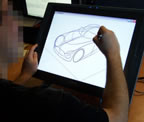CSC490 Fall 2011: Capstone Design course
This course gives students experience solving a substantial problem that may span several areas of Computer Science. Students will define the scope of the problem, develop a solution plan, produce a working implementation, and present their work using written, oral, and (if suitable) video reports. Class time will focus on the project, but may include some lectures. The class will be small and highly interactive.
Professor:
Karan Singh (http://www.dgp.toronto.edu/~karan)
Theme:
 |
 |
 |
 |
 |
| ...sketch bears in 3D | ...and cars, humans | ...infer surface from lines | ...recognize gestures, objects | ...perception of lines |
This capstone will focus on sketch-based techniques. Sketch-based interfaces have often been touted as a “natural” approach to interactive design. While sketching is indeed a promising medium of visual communication, there are a number of inherent limitations in the motor control of the human hand, human drawing skill, perception and the ambiguities of inference, that make the leap from 2D sketching to 3D visual concepts a challenging task. Students will be exposed to a wide range of ideas related to digital sketching.
In this course, we will explore new prototypes for sketch-based interaction in the University of Toronto’s graphics and human-computer interaction laboratory (www.dgp.toronto.edu), including 3D printers, pico projectors, numerous smartphones and tablets, and a variety of other input and output technologies that could be combined to create novel sketch-based content. Students will be given considerable freedom to define projects of their choice, with appropriate advice and assistance provided by the instructor and teaching assistants. Some projects may have graduate student involvement. In short this course is tailored to creative people with good technical skills and a flair for problem solving or research.
Grading scheme:
- project sketch: 5% (due in third class)
- first prototype: 25% (due by mid-Oct. 2011)
- implementation and demo of project: 40% (due by early Dec. 2011)
- final presentation of the project: 20% (due by early Dec. 2011)
- final report and webpage: 10% (due by early Dec. 2011)
Duration:
The class will meet once a week R 11-1 (BA 5181) in the Dynamic Graphics Project lab (http://www.dgp.toronto.edu) or as specified the week before.
There are no exams in this course.
Prerequisites:
The biggest pre-requisite for this course is a creative mind and a can-do attitude.
Understanding of basic image processing and computer graphics concepts and programming is desirable but not essential.
If you want to see the kind of stuff that students produce in this course last time check the film and film credits of the spine by Chris Landreth (NFB Canada).
A number of tools were written to help model the characters and the rendering effects you see in the film.
...or check out the capstone on optical illusions
Here are some other classic projects that resulted in further work or research papers.
Digital Orchestral Score Interface
Hierarchical Spatial Keyframing
Enrolment limit:
The course will be limited to 20 students.
Should demand exceed available spaces, preference will be given to students who have taken two or more of the prerequisite courses, and also to those with higher grades in those courses.
Course Material
Introduction to sketch & sculpt interfaces and prospective projects
Student Prjects